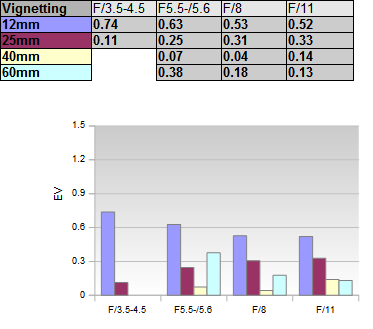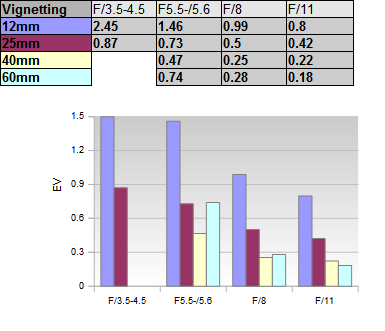|
Panasonic Lumix G 12-60mm f/3.5-5.6 ASPH Power OIS - Review / Test - Analysis |
|
Lens Reviews -
(Micro-)Four-Thirds
|
|
Page 2 of 3

Distortion
The Micro-Four-Third system uses an automatic distortion-correction thus from a user perspective, there is little to worry about. Images only show a moderate degree of barrel distortion (1.6%) a 12mm and there is not much to report about beyond.
While most RAW converter as well as the camera (JPEGs) don't give you a choice, a few still do (e.g Capture One) thus it is possible to verify the original characteristic of the lens. With disabled auto-correction, the Panasonic lens shows a barrel distortion of no less than 6.5% at 12mm. This is, once more, nothing short of excessive really and a sign that the lens was purposely under-designed to save costs and/or reduce the size/weight. Such a level of distortion correction has also a negative impact on the border resolution at 12mm because it results in rather heavy image interpolation. The 25mm setting is much better with a moderate degree of the pincushion distortion. 40mm and 60mm are fairly well corrected.
Vignetting
Auto-correction is also applied to the vignetting characteristic. The system produces a medium light falloff of around 0.7 EV (f-stops) at 12mm f/3.5. Stopping down reduces the issue slightly. It's not a big deal beyond the 12mm setting.
 The situation changes again when looking at the original data (without distortion- nor vignetting- correction). Unsurprisingly 12mm f/3.5 remains the weak spot with a peak vignetting of 2.4EV (f-stop). *cough* Stopping down to f/5.6 resolves some of the issue but f/8 is needed to tame it to a reasonable degree. The other settings aren't overly affected again but it still helps to stop down a little.
Some users are wondering why we are exploring the uncorrected behavior in the first place. Please note that vignetting compensation is NOT lossless. Correcting light-falloff increase the amount of noise due to the required image amplification.
The situation changes again when looking at the original data (without distortion- nor vignetting- correction). Unsurprisingly 12mm f/3.5 remains the weak spot with a peak vignetting of 2.4EV (f-stop). *cough* Stopping down to f/5.6 resolves some of the issue but f/8 is needed to tame it to a reasonable degree. The other settings aren't overly affected again but it still helps to stop down a little.
Some users are wondering why we are exploring the uncorrected behavior in the first place. Please note that vignetting compensation is NOT lossless. Correcting light-falloff increase the amount of noise due to the required image amplification.

MTF (resolution)
The Panasonic Lumix G 12-60mm f/3.5-5.6 ASPH Power OIS managed to deliver a decent albeit generally unexciting resolution. It is slow lens thus the center peak performance is already available at full open aperture (due to diffraction). The center is excellent at 12mm f/3.5 and remains very high till f/8. The outer image region is generally good to very good. The center quality decreases slowly the more you zoom out to 60mm whereas the border/corner quality remains on a good to very good level. Diffraction effects start to have a higher impact beyond f/11. Remember that f/11 is equivalent to "f/22" on full format cameras so it's obvious that you don't really need to stop down that much on micro-four-thirds most of the time anyway.
We tested TWO samples. Both performed fine in the lab but they both showed a centering issue at 60mm in real life images (lower left) which was a little puzzling actually. Usually you can spot such issues during the lab tests already. It may be that the IS group isn't properly locked (which is not relevant on a studio tripod) but this is speculative.
Please note that the MTF results are not directly comparable across the different systems!
Below is a simplified summary of the formal findings. The chart shows line widths per picture height (LW/PH) which can be taken as a measure for sharpness.
If you want to know more about the MTF50 figures you may check out the corresponding Imatest Explanations

Chromatic Aberrations (CAs)
Lateral CAs (color shadows at harsh contrast transitions) are present but remain below 1px on the average at the image borders. As such they aren't really disturbing.

|